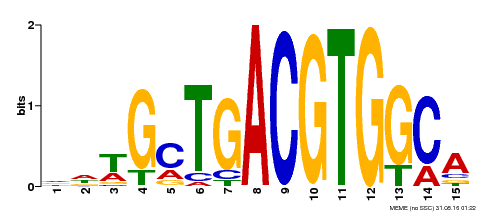| Signature Domain? help Back to Top |
 |
| No. |
Domain |
Score |
E-value |
Start |
End |
HMM Start |
HMM End |
| 1 | bZIP_1 | 38.6 | 2.3e-12 | 31 | 87 | 5 | 61 |
CHHHCHHHHHHHHHHHHHHHHHHHHHHHHHHHHHHHHHHHHHHHHHHHHHHHHHHHH CS
bZIP_1 5 krerrkqkNReAArrsRqRKkaeieeLeekvkeLeaeNkaLkkeleelkkevaklks 61
++ +r+ +NRe+ArrsR RK++ ++ L+ + +L++ N++ + l ++++ k ++
AT2G18160.1 31 RKRKRMLSNRESARRSRMRKQKHVDDLTAQINQLSNDNRQILNSLTVTSQLYMKIQA 87
57899*********************************8877777666666666555 PP
|
| Annotation --
Nucleotide ? help
Back to Top |
| Source |
Hit ID |
E-value |
Description |
| GenBank | AC007212 | 0.0 | AC007212.7 Arabidopsis thaliana chromosome 2 clone F8D23 map PhyB, complete sequence. |
| GenBank | AK230244 | 0.0 | AK230244.1 Arabidopsis thaliana mRNA for hypothetical protein, complete cds, clone: RAFL23-13-A15. |
| GenBank | AY037216 | 0.0 | AY037216.1 Arabidopsis thaliana At2g18160/F8D23.6 mRNA, complete cds. |
| GenBank | AY133545 | 0.0 | AY133545.1 Arabidopsis thaliana At2g18160/F8D23.6 mRNA, complete cds. |
| GenBank | BT000700 | 0.0 | BT000700.1 Arabidopsis thaliana clone RAFL08-13-K01 (R11176) putative bZIP transcription factor (At2g18160) mRNA, complete cds. |
| GenBank | CP002685 | 0.0 | CP002685.1 Arabidopsis thaliana chromosome 2, complete sequence. |
| Publications
? help Back to Top |
- Riechmann JL, et al.
Arabidopsis transcription factors: genome-wide comparative analysis among eukaryotes.
Science, 2000. 290(5499): p. 2105-10
[PMID:11118137] - Jakoby M, et al.
bZIP transcription factors in Arabidopsis.
Trends Plant Sci., 2002. 7(3): p. 106-11
[PMID:11906833] - Ekman DR,Lorenz WW,Przybyla AE,Wolfe NL,Dean JF
SAGE analysis of transcriptome responses in Arabidopsis roots exposed to 2,4,6-trinitrotoluene.
Plant Physiol., 2003. 133(3): p. 1397-406
[PMID:14551330] - Dal Bosco C, et al.
Inactivation of the chloroplast ATP synthase gamma subunit results in high non-photochemical fluorescence quenching and altered nuclear gene expression in Arabidopsis thaliana.
J. Biol. Chem., 2004. 279(2): p. 1060-9
[PMID:14576160] - Yamada K, et al.
Empirical analysis of transcriptional activity in the Arabidopsis genome.
Science, 2003. 302(5646): p. 842-6
[PMID:14593172] - Schluepmann H, et al.
Trehalose mediated growth inhibition of Arabidopsis seedlings is due to trehalose-6-phosphate accumulation.
Plant Physiol., 2004. 135(2): p. 879-90
[PMID:15181209] - Gong W, et al.
Genome-wide ORFeome cloning and analysis of Arabidopsis transcription factor genes.
Plant Physiol., 2004. 135(2): p. 773-82
[PMID:15208423] - Deppmann CD, et al.
Dimerization specificity of all 67 B-ZIP motifs in Arabidopsis thaliana: a comparison to Homo sapiens B-ZIP motifs.
Nucleic Acids Res., 2004. 32(11): p. 3435-45
[PMID:15226410] - Scheible WR, et al.
Genome-wide reprogramming of primary and secondary metabolism, protein synthesis, cellular growth processes, and the regulatory infrastructure of Arabidopsis in response to nitrogen.
Plant Physiol., 2004. 136(1): p. 2483-99
[PMID:15375205] - de Diego JG,David Rodr
cDNA-AFLP analysis of seed germination in Arabidopsis thaliana identifies transposons and new genomic sequences.
J. Plant Physiol., 2006. 163(4): p. 452-62
[PMID:16455359] - Pischke MS,Huttlin EL,Hegeman AD,Sussman MR
A transcriptome-based characterization of habituation in plant tissue culture.
Plant Physiol., 2006. 140(4): p. 1255-78
[PMID:16489130] - Ehlert A, et al.
Two-hybrid protein-protein interaction analysis in Arabidopsis protoplasts: establishment of a heterodimerization map of group C and group S bZIP transcription factors.
Plant J., 2006. 46(5): p. 890-900
[PMID:16709202] - Deppmann CD,Alvania RS,Taparowsky EJ
Cross-species annotation of basic leucine zipper factor interactions: Insight into the evolution of closed interaction networks.
Mol. Biol. Evol., 2006. 23(8): p. 1480-92
[PMID:16731568] - Weltmeier F, et al.
Combinatorial control of Arabidopsis proline dehydrogenase transcription by specific heterodimerisation of bZIP transcription factors.
EMBO J., 2006. 25(13): p. 3133-43
[PMID:16810321] - Cheng C, et al.
An early response regulatory cluster induced by low temperature and hydrogen peroxide in seedlings of chilling-tolerant japonica rice.
BMC Genomics, 2007. 8: p. 175
[PMID:17577400] - Hayden CA,Jorgensen RA
Identification of novel conserved peptide uORF homology groups in Arabidopsis and rice reveals ancient eukaryotic origin of select groups and preferential association with transcription factor-encoding genes.
BMC Biol., 2007. 5: p. 32
[PMID:17663791] - Usadel B, et al.
Global transcript levels respond to small changes of the carbon status during progressive exhaustion of carbohydrates in Arabidopsis rosettes.
Plant Physiol., 2008. 146(4): p. 1834-61
[PMID:18305208] - Ascencio-Ib
Global analysis of Arabidopsis gene expression uncovers a complex array of changes impacting pathogen response and cell cycle during geminivirus infection.
Plant Physiol., 2008. 148(1): p. 436-54
[PMID:18650403] - Wang Y, et al.
Transcriptome analyses show changes in gene expression to accompany pollen germination and tube growth in Arabidopsis.
Plant Physiol., 2008. 148(3): p. 1201-11
[PMID:18775970] - Torti S, et al.
Analysis of the Arabidopsis shoot meristem transcriptome during floral transition identifies distinct regulatory patterns and a leucine-rich repeat protein that promotes flowering.
Plant Cell, 2012. 24(2): p. 444-62
[PMID:22319055] - Efroni I, et al.
Regulation of leaf maturation by chromatin-mediated modulation of cytokinin responses.
Dev. Cell, 2013. 24(4): p. 438-45
[PMID:23449474] - Ezer D, et al.
The G-Box Transcriptional Regulatory Code in Arabidopsis.
Plant Physiol., 2017. 175(2): p. 628-640
[PMID:28864470] - Pedrotti L, et al.
Snf1-RELATED KINASE1-Controlled C/S1-bZIP Signaling Activates Alternative Mitochondrial Metabolic Pathways to Ensure Plant Survival in Extended Darkness.
Plant Cell, 2018. 30(2): p. 495-509
[PMID:29348240]
|





